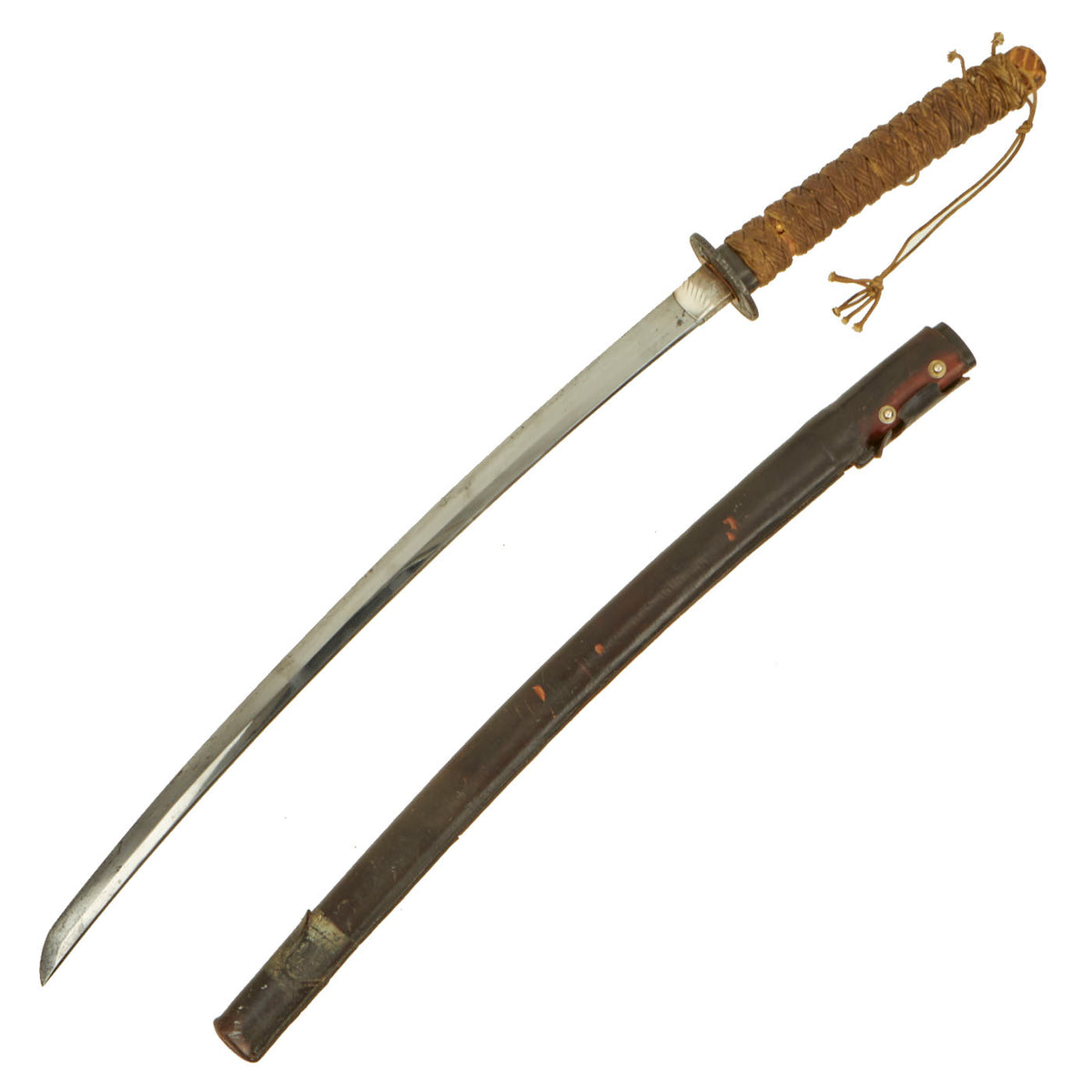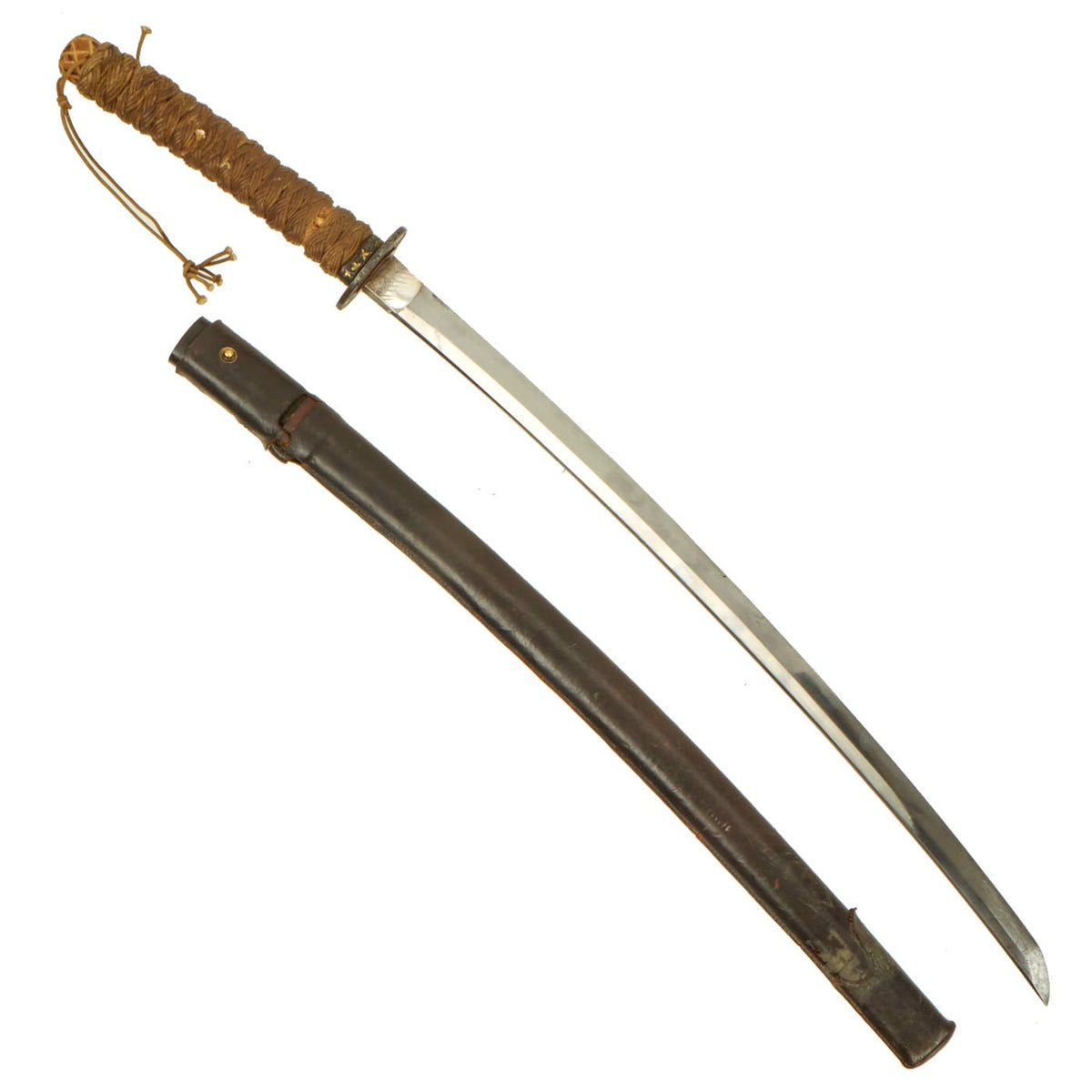Original Edo Period WWII Reissued Japanese Katana Sword with Plaited Rope Grip and Leather Covered Scabbard Original Items
$ 1.995,00 $ 498,75
Original Item: Only One Available. A katana (刀 or かたな or カタナ) is a Japanese sword characterized by a curved, single-edged blade with a circular or squared guard and long grip to accommodate two hands. Developed later than the tachi, it was used by samurai in feudal Japan and worn with the edge facing upward. The official term for katana in Japan is uchigatana (打刀) and the term katana (刀) often refers to single-edged swords from around the world. The katana belongs to the 日本刀 (nihontō) family of swords, and is distinguished by a blade length (nagasa) of more than 2 shaku, approximately 60 cm (24 in).
This example dates from the Edo period (江戸時代, Edo jidai) or Tokugawa period (徳川時代, Tokugawa jidai) of Japanese history. This is the period between 1603 and 1867, when Japan was under the rule of the Tokugawa shogunate and the country’s 300 regional daimyo. We estimate it was from the early 17th century portion. Apparently during WWII it looks to have been put back into service, and mounted in a WWII style leather scabbard cover, and had a new hilt (tsuka) fitted, made of wood covered with plaited cord. We assume this was a “last ditch” modification late in the war.
This example has most likely been remounted several times, as was common for Japanese blades. This has made the file marks (yasurimi) on the tang faint, and given it a lovely patina. There are two holes (mekugi-ana) in the tang, so the cutting edge may have been somewhat longer previously. There is also a smaller hole drilled towards the bottom of the tang, but we believe it is a WWII modification. As there is no maker name on the tang, this blade is considered 無名 (mumei), or “anonymous”.
The blade has the following period correct features:
– Folded steel blade (fold lines are evident on the spine and body of the blade)
– Multiple holes in the tang are punched and not drilled
– blade has a temper line (hamon), which is easily visible.
– Blade wounds (kizu) or lamination artifacts are present on the blade. Both ware (lamination lines) and fukure (carbon pits) are visible.
The Blade of this example is 24 1/4 inches long, with the edge still well and still quite sharp, so handle with care. There are a few areas of denting, and the polish is well retained on most of the blade, while the last 4 inches or so near the tip have some water stains and oxidation, now cleaned away. This has unfortunately removed the original polish in that area. There are also other areas of staining on the blade as shown. Overall length of this katana is 35 inches.
The HAMON (temper line) is still visible, and is of the YAHAZU (notched) MIDARE (Irregular) type, and is quite irregular. NIE Crystals are visible, and there is NIOI cloudiness visible in the hamon with lamination lines. Unfortunately due to the water oxidation damage, the YOKOTE (transition to the tip) and BOSHI (tip temper line) can no longer be visualized. There is visible HADA (grain) in the body of the blade, which is a very nice ITAME (woodgrain) type. The tang (nakago) is of the Futsu 普通 (regular) style, with a Haagari (asymmetrical rounded) nakago-jiri (tip).
The katana has a silver plated engraved Habaki (blade collar), which is typical of the Edo period. The tsuba (cross guard) is made of iron and is the Maru Gata (round) shape, embossed with various Japanese motifs. There are small brass or silver inlays in the eyes of some of the designs, as well as in other places. There is a Hitsu-ana for a scabbard lock on one side, and it is surrounded by two seppa (spacers) The fuchi (collar) for the tsuka (handle) is non magnetic, and looks to be made of bronze, with some gilt designs on one side. The plaited cord wrapping is in good condition, though part at the bottom has torn away. The handle is retained by a single peg, which looks to be a replacement.
The sword comes in a a well fitting ribbed and lacquered wooden scabbard (saya), which was fitted with a hanger ring and leather field cover during the WWII period. The original kurikata (knob) was removed, and a leather hanger installed next to where it used to be, before the covered as fitted. There originally would have been a leather spacer to attach to the snap on the cover, but that is unfortunately missing.
A nice Edo Period katana, refit and reissued for use during late WWII, ready to display!
Specifications:
Blade Length: 24 1/4″
Overall length: 35“
Scabbard Length: 23″
It has been over one thousand years ago that the art of making swords appeared in Japan. The swordsmiths of the time may not have known it but they were creating a legendary sword. The Samurai sword has seen combat in many battlefields. From the early days of the Samurai warrior to the fierce battles in the South Pacific during WWII.
Each hand-made Japanese blade (日本刀 – Nihonto) is unique because it is forged from multiple pieces of folded steel stock. A tremendous amount of work is dedicated to creating these pieces. They were an instrument of war as much as a beautiful artifact to adorn a room.
The traditional Japanese blade and mountings have grown to be one of the most highly desired military antiques.
Fast Shipping with Professional Packaging
Thanks to our longstanding association with UPS FedEx DHL, and other major international carriers, we are able to provide a range of shipping options. Our warehouse staff is expertly trained and will wrap your products according to our exact and precise specifications. Prior to shipping, your goods will be thoroughly examined and securely secured. We ship to thousands clients each day across multiple countries. This shows how we're dedicated to be the largest retailer on the internet. Warehouses and distribution centres can be located throughout Europe as well as the USA.
Note: Orders with more than one item will be assigned a processing date depending on the item.
Before shipping before shipping, we'll conduct a thorough inspection of the items you have ordered. Today, the majority of orders will be delivered within 48 hours. The delivery time will be between 3-7 days.
Returns
The stock is dynamic and we cannot completely manage it because multiple stakeholders are involved, including our factory and warehouse. So the actual stock may alter at any time. It's possible that you may not receive your order once the order has been made.
Our policy is valid for a period of 30 days. If you don't receive the product within 30 days, we are not able to issue a refund or an exchange.
You can only return an item if it is unused and in the same state as the day you received it. You must have the item in its original packaging.
Related products
Uncategorized
Uncategorized
Uncategorized
Armored Burgonet Helmet & Polearm from Scottish Castle Leith Hall Circa 1700 Original Items
Uncategorized
Uncategorized
Uncategorized
Uncategorized
Uncategorized
Uncategorized
Angolan Rebel 1970s era 60mm Inert Display Mortar from Angolan Civil War Original Items
Uncategorized
Uncategorized
Uncategorized
Uncategorized
Uncategorized
Uncategorized
Uncategorized













































































